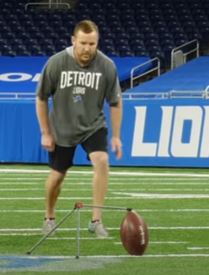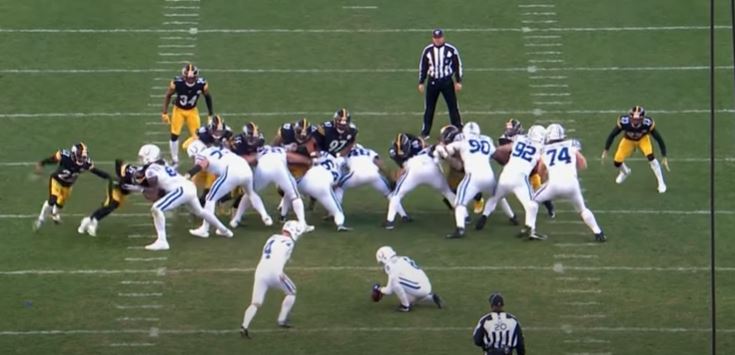PAT in Football: Special Moves by Special teams

Hey!! Do not get confused by the term “special teams.” We are not referring to a team of aliens who can only perform PAT in Football. Here the term “special teams ” refers to those who are already scoring and are allowed to score an extra point. If you are still confused, let us give you a simple definition.
PAT in Football is the acronym for “Point After Touchdown.” The kicker and the holder come into play in this situation. As the name goes, this is an extra point awarded once a team scores six points after the touchdown. The scoring team remains at liberty to choose the “short kick” for making a “one-point conversion.” They can also take a “one-single” attempt from the second-yard line to make the ball go into the endzone.
Contents
What are the two scoring opportunity available for PAT in Football?
The two players, the “kicker” and the “holder” of the special team step in to perform the PAT in Football. But before we jump into describing their roles, let us first introduce you to the term “special team.”
In Football, “Special teams” are smaller units of teams within a team. This team is called on the field when they are about to perform a “kick” or maybe a “return” in the game. This is pretty obvious that when one of the teams brings their “Special Team,” commonly known as the “ST,” to the game, their opponent team also follows suit.
Now in this “Special Team,” there are various players who take the responsibility to perform the PAT in Football.
There are two options to score some extra points after a touchdown. The first one is the “Single Point after Touchdown.” And the second one is where the team gets to score two points after the touchdown. The two ways are opted by the teams by following two different strategies.
The Kicker

The “kickers” are the part of the Special team responsible for earning the “extra point” like the PAT in Football. But they are often used for scoring the extra one point in PAT in Football, where the kicker needs to kick off the ball to a field goal from a distance of 33 yards. There are other specifications for the one-point score, which are discussed later in the article.
The Holders

Before the kicker makes their move, there are the holders who make sure the ball is in position. If you think it is an easy job to hold the ball for the kickers for the PAT in Football, think again!! The holders need to be very steady when they have the ball. Because otherwise, there is a very high chance that the team misses a field goal or the kicker misses the ball.
There are other positions like the gunner, the snapper, the punter, and others.
The two scoring options
The Single Point
If you were given a choice to score one extra point and two extra points, which one would you choose? Of course, you would select the second option. The same goes when deciding on the PAT in Football. The single-point scoring after a touchdown is not a very popular choice. But this is a safer option when compared to the two-point conversions.
Now how to get that?
To earn the single point, the kicker who has been brought into the game by the special team kicks a field goal from a specified distance of 33 yards. There are still some regulations that one needs to take care of while kicking it. The action needs to take place on the “fifteen-yard” line. Here, it would result in keeping the uprights at the back of the endzone.
If the kickers can achieve the field goal successfully, they earn one extra point in the PAT in Football. They accomplish this most of the time.
The rules for this has changed a few time. Previously the kickers had to attempt these field goals from the two-yard lines. As a result, it often resulted in the distance to reduce by almost 13 yards compared to today’s norms. Ultimately, there was hardly any kicker who used to miss these PAT in Football due to the less distance.
The Two Points
Although it is a better option from the “more score” view, it is less common than the single-point PAT in Football.
In this conversion, the offense is allowed to stay on the field. By the term “offense,” we mean the team that has the ball and is moving towards the “endzone” of the opponent to score the points.
In this two-point conversion of PAT in Football, the rule is that the ball starts at the “two-yard” line. The offense gets only a single opportunity to get it into the endzone.
In an attempt to achieve the two-point conversion, if the offense can utilize the opportunity and make it to the endzone with the ball, they are awarded the promised points. But if they fail to do so, no point is awarded.
There is also a “catch” in this. If the offense makes a “turnover,” they lose the ball for any reason. The opponent team is entitled to score the two points of the offense.
So from the above explanations, we hope it is clear why the players choose the lesser points option for the PAT in Football.
FAQs on PAT in Football
How long is the PAT in Football nowadays?
According to the latest rules, the PAT in Football is 33 yards.
When did the PAT first apply in Football?
It was first started in 1994.
Is it possible to fake the PAT in Football?
Yes. It’s entirely legal, but it’s also dangerous. If you’re in a situation where you need two points, simply set up for two and shoot.






